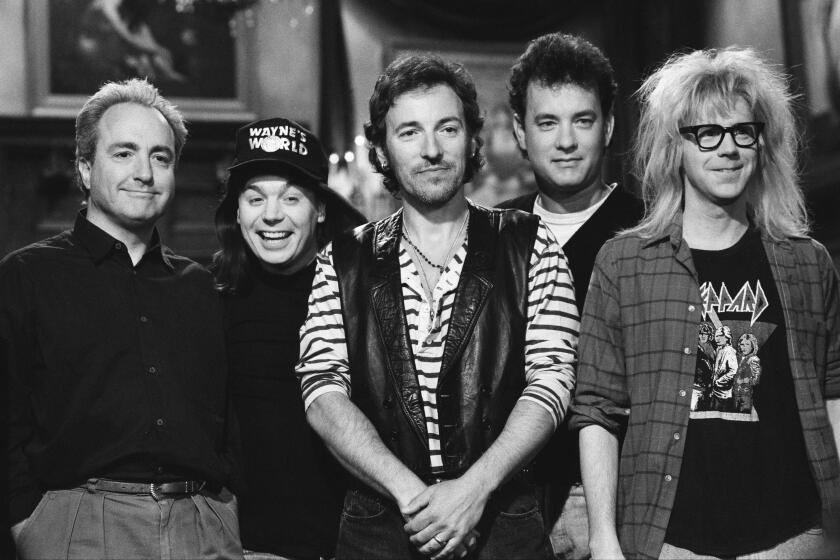For a New Beginning, a Glorious ‘Creation’
- Share via
CLEVELAND--With so much attention going to Simon Rattle’s anticipated musical revolution in Berlin and Lorin Maazel’s provocative move to New York, a new musical era in Cleveland may not seem quite so momentous. Certainly, the fact that Franz Welser-Most became music director of the Cleveland Orchestra last week attracted less attention than the outrage in some quarters over a senior, often eccentric conductor such as Maazel taking over the helm of the New York Philharmonic at the same time or the excitement that the feisty Rattle generated as he assumed the helm at the Berlin Philharmonic earlier in the month.
But while Cleveland may not be New York or Berlin, there should be no underestimating the importance of its great symphony orchestra. The most memorable orchestral performance in my experience was by the Cleveland Orchestra of Debussy’s “La Mer,” conducted nine years ago by Pierre Boulez at Carnegie Hall in New York. The intoxicating vibrancy of the playing transcended perfection, transcended the virtuosity and brilliance typical of the New York and Berlin bands. So compelling was the Clevelanders’ identification with every note they played that it was as if listening was no longer listening, as if music incorporated all five senses.
That may have been a once-in-a-lifetime experience, but at least the memory of it came back to me at Severance Hall on Saturday night when Welser-Most conducted a warm, lustrous, numinous performance of Haydn’s “The Creation,” the oratorio he chose to begin his first season with the orchestra.
When the announcement of Welser-Most’s appointment was made in 1999, it was a surprise. Having now just turned 42, he is thought of as still young and perhaps not yet ready for such a prestigious post, even though he is the same age Maazel was when he began his 10-year term as music director in Cleveland 30 years ago. The rocky time Welser-Most had as music director of the London Philharmonic, which he led from 1990 to 1996 when he really was young, was not forgotten, though it should be. Since then he has had a successful tenure at the Zurich Opera and has become an international guest conductor in great demand.
There is, in fact, little fear of Welser-Most repeating his youthful problems in London, where he was perceived as too inexperienced and a too-provincial young Austrian. He has grown impressively as a conductor and his musical interests have also widened broadly, now including cutting-edge American and European work. Programming for his first season in Cleveland is admirable, and particularly noteworthy is his bravery in including the kind of challenging new European work--from the likes of Hanspeter Kyburz, Matthias Pintscher, Kaija Saariaho, George Benjamin and Mark-Anthony Turnage--that typically scares away other American orchestras, and certainly in such large doses.
For instance, the New York Philharmonic staged a preseason opening gala on Wednesday for Maazel with only Beethoven. Meanwhile, Welser-Most led a gala in Cleveland a week ago that included, along with a Haydn symphony and some bonbons, the world premiere of a Modernist work by the exciting young French composer Marc-Andre Dalbavie, which was commissioned to celebrate the opening of a Frank Gehry Case Western Reserve University building that is a new Severance Hall neighbor.
Cleveland, moreover, has done a splendid job paving the way for Welser-Most. The orchestra, made famous by George Szell in the ‘50s and ‘60s, couldn’t be in better shape after some two decades under Christoph von Dohnanyi, now music director laureate. Severance Hall underwent a renovation two years ago that not only added a welcome new bloom to its already fine acoustics but also enhanced the natural beauty of its ornate interior to a breathtaking new level.
The mood for “The Creation” Saturday, the third and final night for this first program, was uplifting. The soloists--soprano Malin Hartelius, tenor James Taylor and, especially, baritone Thomas Quasthoff--were ideal; the large Cleveland Orchestra, very solid. The performance was sleek and sure, giving the sensation of not so much interpreting this powerfully descriptive work as illuminating it.
There was one intriguing problem in playing “The Creation” in Cleveland, which Welser-Most did not completely solve. Haydn’s score begins famously with the depiction of chaos, with a remarkably musical description of “the Earth without form and void” through a blurry musical structure and striking dissonances. Perhaps it was simply unreasonable to expect an orchestra that plays with such a unified sound to appear dramatically chaotic.
Still, who can complain about an extraordinary ensemble making an extraordinary effort for its new music director? Welser-Most still must grow to fill the role of music director of the Cleveland Orchestra, and this ultimately stirring first performance provided encouraging first signs that he will. But his fresh and sophisticated programming should have its beneficial effect on keeping this secure orchestra on its toes as well.
More to Read
The biggest entertainment stories
Get our big stories about Hollywood, film, television, music, arts, culture and more right in your inbox as soon as they publish.
You may occasionally receive promotional content from the Los Angeles Times.











